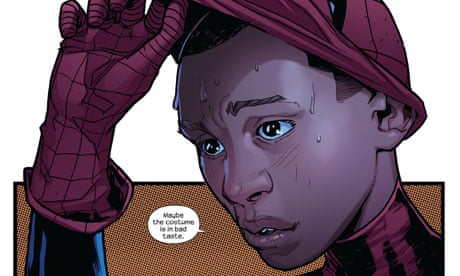There's a fine line between rejuvenation of a tired franchise and flogging a dead horse. The job of PR is to make that horse look thrillingly virile, blinding us momentarily to the maggots in its hide, distracting us from the almighty pong of its decomposition. When it comes to the superheroes that have been part of America's cultural landscape for the last 70 years, the PR brigade is working overtime.
The latest news from the boardrooms of Marvel Comics is that Spider-Man is to be relaunched as a half-black, half-Hispanic character. Yes, Peter Parker will become Miles Morales. Axel Alonso, Marvel's chief editor has declared: "When Spider-Man peels back that mask, there will be a whole new demographic of kids who we'll be reaching on a new spiritual level. We wanted to make a statement about the 21st century."
All very Barack Obama. But let's have a reality check here. Spider-Man was invented 50 years ago, and swiftly became Marvel's most popular character. The company did what companies always do when a product hits big: they manufactured more product. The original Amazing Spider-Man magazine was joined by Spectacular Spider-Man, Web of Spider-Man, Spider-Man Family, Ultimate Spider-Man and many, many others. Thousands of storylines were spun, each increasingly desperate to milk some more web-fluid out of the property. Each super-villain was killed and reanimated and re-killed ad infinitum. Spidey's secret identity was revealed, re-hidden, revealed, re-hidden. Fans gawped in exasperation when Peter Parker's moribund Aunt May was finally shot, only for Peter to make a bargain with the demon Mephisto to resurrect her in exchange for the erasure of Peter's marriage to Mary Jane. Confused? It gets a lot more complicated than this.
Most cynical of all has been the Ultimate series of storylines, set in an alternate universe. It's here that the half-black, half-Hispanic Spider-Man has been floated, while his white counterpart continues to reign supreme in the regular comics – how's that for tokenism? Despite the "change-we-can-believe-in" oratory of the Marvel spinmeisters, it's understood that nothing in the Ultimate universe matters a damn. In these storylines, Marvel's heroes and heroines are brusquely decapitated, drowned, strangled, raped, eaten and so on. Spider-Man was blown up in Ultimatum #4 last year, then killed again in Ultimate Spider-Man #160 this June.
In truth, few people care anymore what happens in the comics. Marvel, after a series of corporate takeovers, is now a plaything of the Disney conglomerate. Sales of comics have plummeted since their heyday in the 1960s and 70s. As this week's promotional images of a new Superman film remind us, movies are where the money is these days. In Warner Bros' forthcoming Man of Steel, Henry Cavill has been beefing up for the role, and offers us this profound meditation on the significance of donning the fabled costume: "It's extremely cool." Cavill, typical of the actors chosen to play superheroes these days, comes across as a narcissistic hunk who wouldn't recognise heroism if it bit him on the biceps. He joins Ryan Reynolds's gauchely insincere Green Lantern, Chris Hemsworth's gravitas-free Thor, Christian Bale's shark-eyed, hollow Batman, and all those preening, vacuous X-People. Peel off the gloss and the CGI, and you'll see a horde of dead horses shambling towards you.
